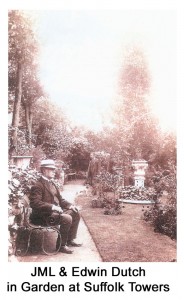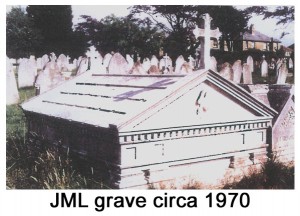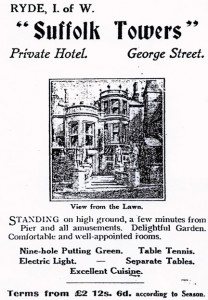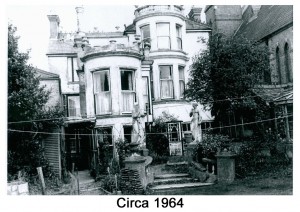Suffolk Towers, 84 George Street, Ryde
Researched by Joann Bailey and Anthony J Merry
With some information supplied by Percy Dutch
SUFFOLK HOUSE as it was originally called was built in the late 1830’s for the Rev. T S GUYER, Minister of the Congregational Church in Ryde, from 1817 to 1846.
By the late 1840’s it was home to a dentist, George Fellows HARRINGTON JP. As well As being a dentist George Harrington was an inventor and in 1849 he patented mineral teeth and later plates of tortoiseshell . In 1864 he patented a clockwork dental drill the speed of which, once wound up, was controlled by the thumb and it would run for about two minutes. The main drawback being the noise the drill made.
Sometime later, probably in the late 1860’s, the house was owned by JOHN MORTIMER LOUSADA who at the time would have been a comparatively young man, in his 20s.
Born on the 29th December 1841, he was reputed to have had claim to the title of Count from the Italian side of the family. As he lived on very substantial private means, possibly inherited, it is assumed that it was he who transformed SUFFOLK HOUSE into SUFFOLK TOWERS. It must have taken a lot of money to enlarge and embellish the house with the tower, urns and balustrades, etc in the Italian style made very fashionable by Prince Albert at Osborne House. The Victorian builders did a very impressive job but some of their building methods, if not quite “Jerry Building” did cause terrible problems in later years. Load bearing metal lintels and girders rusting through and expanding to burst brickwork and rendering and dry rot from roof to foundations eating away timber lintels, framing and joist ends, etc. However, the Plasterers responsible for the exterior and interior rendering and mouldings were worth their “weight in gold”, what the eye doesn’t see…….
A summer house was built at the rear of the house against the Baptist Church boundaries, and the garden then covering most of the area which is now the lower part of George Street Car Park was set out with more ornamental Pots and Urns, Statues of the Four Seasons and a Fountain. It appears that “JML” continued to make improvements at least up until the turn of the century. The marble and tiled fireplace surround may have been in place early on but the cast iron doors are dated 1898. Also at some point painted ceramic bell pushes were installed in the main rooms connected to an indicator board in the scullery.
A Gas Company based in Union Street was engaged to lay many yards of narrow gauge lead piping under floors and in walls to supply gas for lighting. Invoiced in this work, which must have taken some time to complete, was one Edwin DUTCH who impressed JML so much, he asked the Company to release him into his employment to become his “Gentleman’s Gentleman”. The Company was happy to oblige such a good and worthy customer. It is not known whether any money changed hands.
It is possible that Edwin took up residence in the adjoining cottage, No 82 George Street, as there is evidence of a door having at sometime been in the party wall between 82 and 84. It is known that Edwin’s nephew Percy and family were living at 82 in the 1940’s. JML also employed a cook but seemed to have a problem communicating with women and all his wishes were passed on to the cook via Edwin!
The cook apparently also had a problem but hers was drink, a beer bottle was found many years later stuffed up the chimney of the attic room she used to the right of the tower.
Maybe it was just the cook JML had a problem with as, so the story goes, he liked to admire the ladies from a vantage point at the bay window of the first floor lounge to the left of the tower. This is a very big room, running from the front to the back of the house, in which he had two grand pianos, one at each end. Northfield House, opposite in George Street, has a canopy over the steps from the front door to the pavement. One would assume to give shelter and protection from door to carriage in bad weather. However, the story also goes that it was erected to protect the ladies modesty from JML’s gaze as they raised their skirts to negotiate the steps!
JML had a fear of being buried below ground so when he died on March.14th 1929. He was interred at Ryde Cemetery in a large stone sarcophagus in style of a Greek or Roman Temple, very grand and doubtless, very expensive. Today, only the roof and a few inches are exposed, the rest including JML are buried against his dying wishes.
A chance conversation with an old gravedigger around 1970 supplied a possible answer. He stated that during the Second World War a bomb landed somewhere near the cemetery and fearing a direct hit, and I quote, ”We weren’t going to have that old B……… bones scattered around the grave yard, so we sunk it” . A direct hit would, of course, have scattered everybody’s bones. True or not, what is known is that JML, in later life was a frequent visitor to Ryde cemetery.
In the 1930’s the house was owned by two sisters and as the advert in the “Ryde and Seaview Guide” proclaimed became The Suffolk Towers, Private Hotel. It offered “well appointed rooms, delightful garden, nine hole putting green, table tennis, separate tables, excellent cuisine and electric light”. All this on offer for as little as £2-12s-6p per week!
At, or just before the outbreak of the Second World War, the ladies emigrated from England to New Zealand. The house was then requisitioned by the Home Guard who seemed to have done their best to trash the place.
Tod SIMMONS from southeast London bought the house. Then in 1946 he sold it to his sister and brother-in-law Charles Henry and Elizabeth BAILEY. They continued to run the Guest House, into the 1960’s and then later, rented out some of the rooms.
In 1972 the building was given a Grade 2 listing and also during their tenure, after a threat of compulsory purchase, they reluctantly sold a large part of the garden to the Council for the George Street Car Park. In 1976 they sold the house to their daughter Joann BAILEY and Anthony MERRY who embarked on major renovations. By 1983 these were nearly completed but the costs had taken a terrific toll on their limited finances. In this situation they accepted a loss making offer in 1984 from the I.W Area Health Authority and Suffolk Towers became Ryde Health Clinic
At the time of writing, July. 2006, it is understood that due to NHS cutbacks, the clinic is due to be closed and Suffolk Towers sold once again.
Anthony J Merry.
15th July 2006






